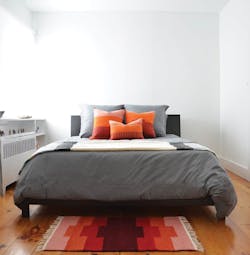Bringing one’s native culture to a new land is not a recent phenomenon, but in our increasingly global world, the distance between the two seems to be narrowing. Products influenced by someone’s roots no longer migrate nor are they copied; they can offer a collaboration between the lands a person is from and where they are now.
Hana Getachew, owner and designer for textile brand Bolé (pronounced "boh-lay") Road, was born and raised for a time in Ethiopia, which helped influence the use of vibrant colors in her textiles. From her home in New York City, she collaborates with makers who are able to bring her designs to life. Of the collective she works with, she said, “I love going back [to visit Ethiopia]. It really feels like a homecoming. It’s become a familial relationship, and I appreciate that. It’s the best part of what I do—that I work with people I genuinely like.”
However, going out on her own as a business owner is a new endeavor for Getachew, who graduated with a degree in Interior Design from Cornell University. Previously, she worked as associate principal at Studio Architecture in New York City, focusing on commercial interiors. “I mostly did workspace—really fun workspaces. I had a lot of great media clients and large-scale projects with limited budgets, so I had to be really creative with the brand’s aesthetic and culture across the design. That’s when I really learned that I love the process, and to design textiles and wallcoverings.”
After 11 years, she took the jump into entrepreneurship and began Bole Roads, named after the main thoroughfare of her birthplace, Addis Ababa. On her website, Getachew explained that Bolé Road played a “pivotal” role in shaping her work. During her trip there 18 years after she left at the age of three, Getachew stated, “I knew I wanted to be more connected to Ethiopia. I wanted to be more involved in the lives of its people and to contribute to its development. I also wanted to harness the overwhelming beauty and power of my first homecoming. As the years passed, I decided the best way to do that was by sharing the traditions and culture of my heritage with others.”
It’s this bond with her culture and heritage that influences Getachew’s designs, adding a pop of color to interiors with a hand-woven touch, connecting the user to those who made their product overseas.
Getachew was eager to explain that the independence to follow her passions through entrepreneurship was a major “pro” of her work, but going out on one’s own as a fledgling company—particularly one who collaborates with makers on another continent—isn’t without its hardships. “The con, of course, is that building up a business is not easy. Especially if you’re creative, handling the business side isn’t something that always comes naturally. When I worked in a larger firm, I never had to think about those administrative things; I just had more time to be creative. But if you’re a business owner, you really have to switch your hat and manage [the organization]. It’s still worth it, but it’s not all play time.”
Additionally, she pointed out that communication between herself and the collaborative in Ethiopia is met with some difficulties. “I went with a small collective in Ethiopia and they don’t have access to computers and internet. So I have to be creative in ways to send information and receive information from them. That’s the most challenging part; just keeping the communication lines open, and making sure nothing is lost in translation, which inevitably it is.”
However, Getachew’s passion for working with makers and her roll-with-the-punches attitude have allowed her to see the beauty in the miscommunication. “Once the fabric is woven you get to [say], ‘Ok, I wasn’t so clear on this.’ But the great part is sometimes I don’t correct it. Sometimes there’s a miscommunication that comes out in the design; something’s a different color or has a different construction than I intended, but it looks so much better than what I designed. That’s the best. You have to love things like that. It’s part of working with humans on a handmade product.”
As for the future, Getachew wants to continue to expand with an eye toward producing fabric by the yard for upholstery. In the meantime, her designs have been used in well-trafficked spaces, like Herman Miller showrooms, and the response during the trade show junket has been phenomenal. The Bolé Road designs continue to bridge the gap between two sides of the world, proving that Earth is much smaller than it appears.
boleroadtextiles.com | Photography courtesy of Hana Getachew
About the Author

Kadie Yale
Former Editor-in-Chief
Kadie Yale holds a BA in Industrial Design from San Francisco State University and a MA in Decorative Art History and Theory from Parsons the New School. In her role as editor-in-chief from 2015-2018, she led the interiors+sources team in creating relevant content that touches on sustainability, universal design, science, and the role of design in society.
